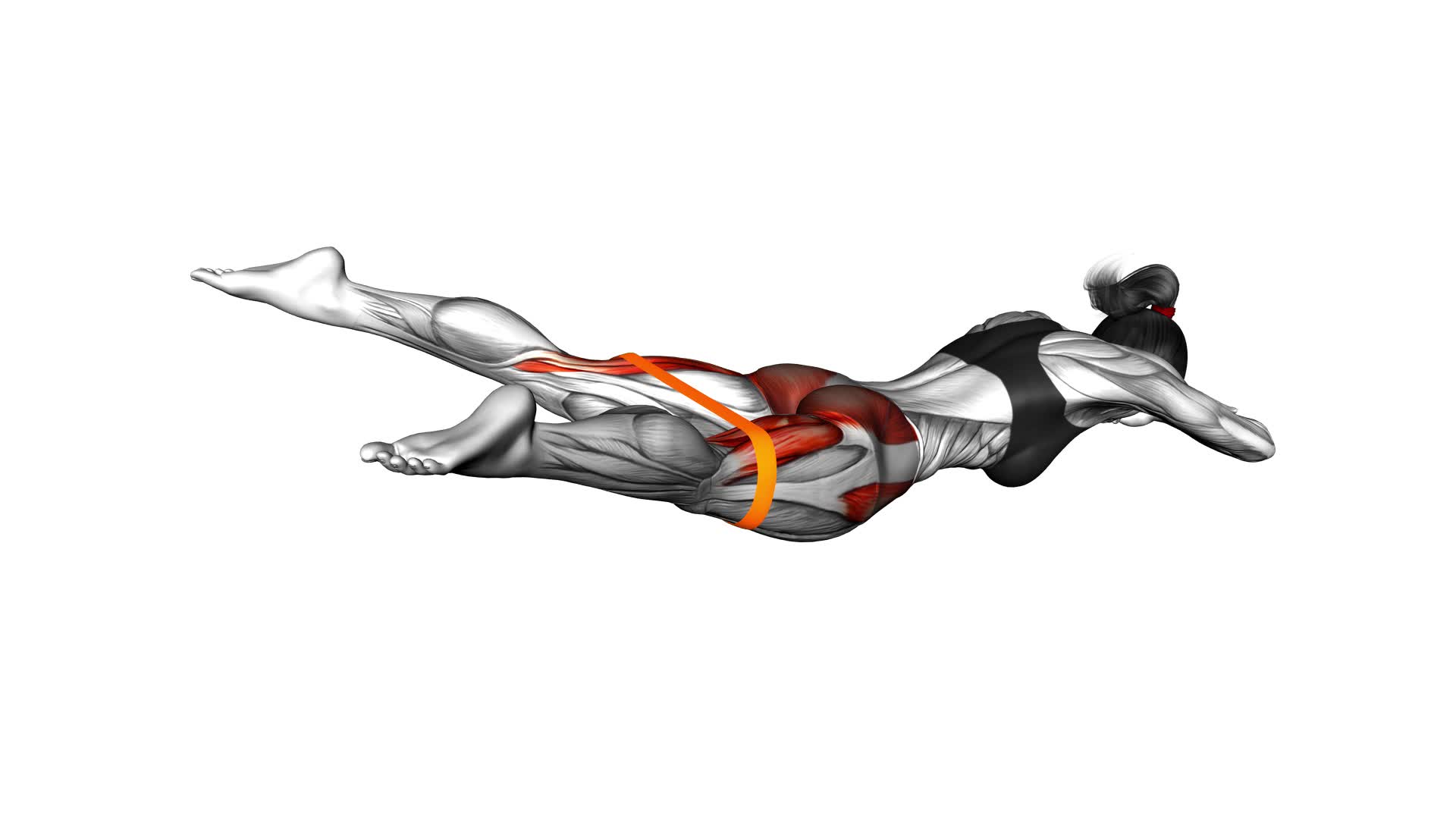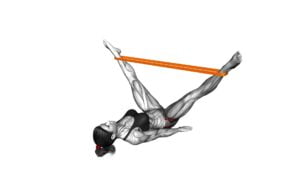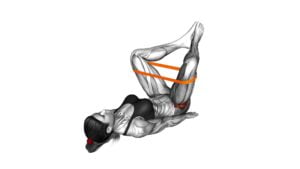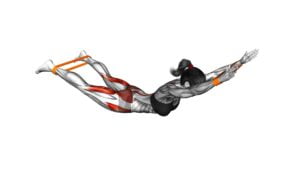Resistance Band Lying Hyperextension Abduction (female) – Video Exercise Guide & Tips

Are you looking for an effective exercise to strengthen your glutes and core? Look no further than the resistance band lying hyperextension abduction. This exercise targets multiple muscle groups while also improving stability and balance.
Watch This Exercise Video
In this video exercise guide, you will learn the proper set-up, technique, and variations to suit your fitness level. Get ready to feel the burn and take your workouts to the next level with this challenging yet rewarding exercise.
Key Takeaways
- Resistance Band Lying Hyperextension Abduction targets multiple muscle groups and strengthens core muscles
- It improves stability, balance, and prevents lower back pain
- This exercise provides a low-impact workout and can be adjusted for all fitness levels
- It is important to choose the right resistance band, maintain proper form, and listen to your body throughout the exercise.
Benefits of Resistance Band Lying Hyperextension Abduction
You can experience significant benefits from incorporating resistance band lying hyperextension abduction exercises into your workout routine. These exercises are effective in improving core strength and preventing lower back pain.
Resistance band lying hyperextension abduction exercises specifically target the muscles in your core, including your lower back, abdominals, and glutes. By engaging these muscles, you can strengthen your core, which is essential for overall stability and balance. A strong core also helps improve your posture, reducing the risk of developing lower back pain.
Additionally, resistance band lying hyperextension abduction exercises provide a low-impact way to work your muscles. Unlike traditional weightlifting exercises, resistance bands offer constant tension throughout the movement, which can help build muscle endurance without placing excessive strain on your joints.
Incorporating these exercises into your routine can also help prevent lower back pain. By strengthening the muscles in your core, you provide better support for your spine, reducing the likelihood of experiencing discomfort or injury. Furthermore, the controlled movements of resistance band exercises can help promote proper alignment and form, further minimizing the risk of lower back pain.
Proper Set-Up and Equipment for the Exercise
To properly set up and perform the Resistance Band Lying Hyperextension Abduction exercise, you'll need a resistance band and a flat surface to lie on. Here are some tips to help you set up your resistance band and choose the right equipment:
- Choose the right resistance band: Make sure the resistance band you select provides enough tension to challenge your muscles without causing strain or discomfort. It should allow you to perform the exercise with proper form and control.
- Secure the resistance band: Attach one end of the resistance band to a sturdy anchor point, such as a door frame or a heavy piece of furniture. Ensure that it's securely fastened to prevent any accidents or injuries during the exercise.
- Position yourself correctly: Lie face down on a flat surface, such as a yoga mat or an exercise mat. Extend your legs fully and keep them together.
- Place the resistance band: Loop the other end of the resistance band around your ankles, ensuring a snug but comfortable fit. The band should be positioned just above your heels.
- Maintain proper form: Throughout the exercise, keep your core engaged and your back straight. Avoid arching your lower back or lifting your hips off the ground. Focus on using your glutes and hamstrings to lift your legs against the resistance of the band.
Step-by-Step Guide for Performing the Exercise
Now that you have properly set up the resistance band and equipment, how do you perform the Resistance Band Lying Hyperextension Abduction exercise? Follow these step-by-step instructions to ensure proper form and maximize the effectiveness of the exercise.
- Lie on your stomach with your legs extended and the resistance band looped around your ankles.
- Engage your core muscles and squeeze your glutes to stabilize your body.
- Begin by lifting your legs off the ground, keeping them straight and parallel to the floor.
- Slowly open your legs out to the sides, maintaining tension in the resistance band.
- Pause for a moment at the peak of the movement, feeling the squeeze in your glutes and outer thighs.
- Slowly bring your legs back together, resisting the pull of the band.
- Repeat for the desired number of repetitions.
To avoid common mistakes, make sure to keep your core engaged throughout the exercise and avoid lifting your upper body off the ground. Additionally, be mindful of your leg alignment and avoid letting your knees collapse inward.
For beginners, you can modify this exercise by using a lighter resistance band or reducing the range of motion. Gradually increase the intensity and range of motion as you become more comfortable and stronger.
Remember to listen to your body and stop if you experience any pain or discomfort. Proper form and gradual progression are key to safely and effectively perform the Resistance Band Lying Hyperextension Abduction exercise.
Tips for Correct Form and Technique
For optimal results, maintain proper alignment and engage your muscles throughout the Resistance Band Lying Hyperextension Abduction exercise. This will ensure that you're targeting the correct muscles and maximizing the benefits of the exercise.
Here are some tips to help you maintain proper form and technique:
- Avoid arching your lower back: Keep your core engaged and your lower back flat on the ground throughout the exercise. This will prevent excessive strain on your back and help you target your glutes and hamstrings effectively.
- Keep your legs straight: Avoid bending your knees during the exercise. This will ensure that you're engaging your glutes and hamstrings fully and preventing any unnecessary stress on your knee joints.
- Control the movement: Avoid swinging your legs or using momentum to complete the exercise. Focus on a slow and controlled movement to engage your muscles properly.
- Start with lighter resistance: If you're a beginner, it's recommended to start with lighter resistance bands. This will allow you to focus on maintaining proper form and gradually increase the intensity as you build strength.
- Listen to your body: Pay attention to any discomfort or pain during the exercise. If you feel any strain or discomfort, modify the exercise or consult with a fitness professional to ensure you're performing it correctly.
Variations and Progressions for All Fitness Levels
To progress the Resistance Band Lying Hyperextension Abduction exercise for all fitness levels, you can incorporate variations that challenge different muscle groups. These progressions and modifications will help you continue to challenge yourself and make progress in your fitness journey.
For beginners, you can start by using a lighter resistance band or reducing the range of motion. This will allow you to focus on mastering the technique and building strength gradually.
To increase the difficulty, you can try using a heavier resistance band or increasing the range of motion. This will engage the muscles more intensely and provide a greater challenge.
For those looking for an advanced variation, you can combine the Resistance Band Lying Hyperextension Abduction exercise with other exercises such as glute bridges or hip thrusts. This will target the glutes and hamstrings even more intensely.
Additionally, you can try incorporating unilateral movements by performing the exercise with one leg at a time. This will further challenge your stability and core strength.
Remember to always listen to your body and progress at a pace that's comfortable for you. These variations and progressions will help you continue to improve and reach your fitness goals.
Frequently Asked Questions
How Many Sets and Repetitions Should I Do for the Resistance Band Lying Hyperextension Abduction Exercise?
For the resistance band lying hyperextension abduction exercise, it's important to find a balance between challenging yourself and avoiding lower back pain.
Start with 2-3 sets of 12-15 repetitions and see how your body responds.
If you experience any discomfort or pain, decrease the number of repetitions or consult a professional.
Remember to listen to your body and adjust the sets and repetitions accordingly to ensure a safe and effective workout.
Can I Perform This Exercise if I Have Lower Back Pain?
If you're dealing with lower back pain, it's important to modify the resistance band lying hyperextension abduction exercise. To prevent further discomfort, try reducing the range of motion and the intensity of the exercise. Additionally, make sure to engage your core muscles and maintain proper form throughout the movement.
Remember to listen to your body and stop if you experience any pain. Always consult with a healthcare professional before attempting any new exercises, especially if you have existing lower back pain.
Is It Necessary to Have a Resistance Band Specifically Designed for This Exercise, or Can I Use Any Type of Resistance Band?
It's not necessary to have a resistance band specifically designed for this exercise. You can use any type of resistance band as an alternative.
However, using a resistance band designed for this exercise can have its benefits. It provides the right amount of resistance and stability to target the muscles effectively.
What Muscles Does the Resistance Band Lying Hyperextension Abduction Target?
The resistance band lying hyperextension abduction targets multiple muscles in your body. It primarily works your glutes, hamstrings, and lower back muscles.
By using a resistance band, you can add extra tension and resistance to the exercise, making it more challenging and effective.
Variations of this exercise include adjusting the position of your legs or using different resistance band tensions to target specific muscle groups.
Can I Incorporate This Exercise Into My Regular Workout Routine, or Should It Be Done as a Standalone Exercise?
You can definitely incorporate the resistance band lying hyperextension abduction into your regular workout routine. It targets multiple muscles in your lower body and core, making it a great addition to a full body workout.
However, if you prefer to focus solely on strengthening and toning your glutes and hamstrings, doing this exercise as a standalone can also be beneficial.
It all depends on your fitness goals and preferences.
Conclusion
In conclusion, the resistance band lying hyperextension abduction is a beneficial exercise for strengthening the muscles in the lower body. Proper set-up and equipment are essential for performing the exercise correctly. By following the step-by-step guide and using the provided tips, individuals can ensure correct form and technique.
Furthermore, variations and progressions are available to accommodate all fitness levels. Incorporating this exercise into a fitness routine can help improve overall lower body strength and stability.

Author
Years ago, the spark of my life’s passion ignited in my mind the moment I stepped into the local gym for the first time. The inaugural bead of perspiration, the initial endeavor, the very first surge of endorphins, and a sense of pride that washed over me post-workout marked the beginning of my deep-seated interest in strength sports, fitness, and sports nutrition. This very curiosity blossomed rapidly into a profound fascination, propelling me to earn a Master’s degree in Physical Education from the Academy of Physical Education in Krakow, followed by a Sports Manager diploma from the Jagiellonian University. My journey of growth led me to gain more specialized qualifications, such as being a certified personal trainer with a focus on sports dietetics, a lifeguard, and an instructor for wellness and corrective gymnastics. Theoretical knowledge paired seamlessly with practical experience, reinforcing my belief that the transformation of individuals under my guidance was also a reflection of my personal growth. This belief holds true even today. Each day, I strive to push the boundaries and explore new realms. These realms gently elevate me to greater heights. The unique combination of passion for my field and the continuous quest for growth fuels my drive to break new ground.







